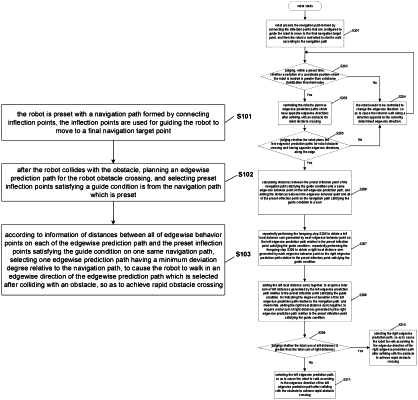| CPC G05D 1/0214 (2013.01) [G05D 1/0227 (2013.01)] | 19 Claims |

|
1. An edgewise path selection method for robot obstacle crossing, comprising:
first, planning an edgewise prediction path for the robot obstacle crossing, and selecting, on a navigation path which is preset, preset inflection points satisfying a guide condition, wherein the navigation path formed by connecting inflection points is preset for a robot, the robot is a visual sweeping robot; the inflection points are used for guiding the robot to move to a final navigation target point;
then according to information of distances between all of edgewise behavior points on each of the edgewise prediction path and the preset inflection points satisfying the guide condition on one same navigation path, selecting one edgewise prediction path having a minimum deviation degree relative to the navigation path, to cause the robot to walk in an edgewise direction of the edgewise prediction path which is selected after colliding with an obstacle, so as to achieve obstacle crossing,
the edgewise path selection method for robot obstacle crossing further comprising:
after the robot starts walking according to the navigation path, judging, within a preset time, whether a variation of a coordinate position where the robot is located is greater than a distance stabilization threshold value, if the variation of the coordinate position where the robot is located is greater than the distance stabilization threshold value, controlling the robot to plan the edgewise prediction path, if the variation of the coordinate position where the robot is located is not greater than the distance stabilization threshold value, controlling the robot to change the edgewise direction, to cause the robot to walk in a direction opposite to the edgewise direction which is currently determined, the edgewise direction which is currently determined including a preset edgewise direction when the robot is powered on and an edgewise direction of the edgewise prediction path that is selected last time and has the minimum deviation degree relative to the navigation path; and controlling the robot to walk in the direction opposite to the edgewise direction which is currently determined if it is determined that two edgewise prediction paths which are used for the robot obstacle crossing and have opposite edgewise directions are unable to be planned, wherein the distance stabilization threshold value is set to a diameter of a body of the robot.
|